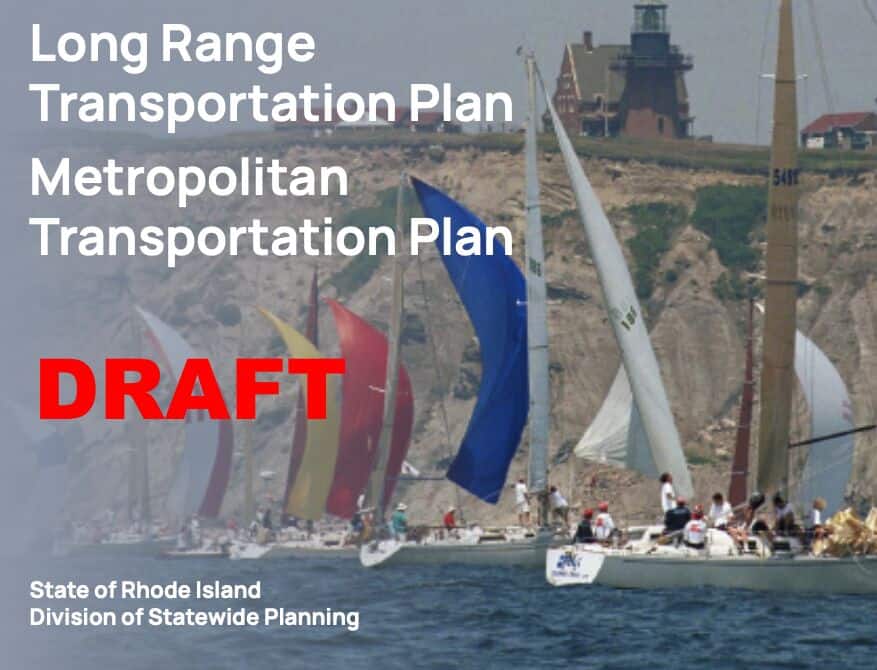
Rhode Island Long Range Transportation Plan (LRTP) – Moving Forward 2050
On July 11th, Bike Newport submitted these comments to the Rhode Island Division of Statewide Planning in response to the Draft Long Range Transportation Plan, “Moving Forward 20250,” which can be viewed here: https://planning.ri.gov/planning-areas/transportation/long-range-transportation-plan
To the Division of Statewide Planning:
Thank you for the opportunity to comment on Rhode Island’s LRTP. Please note that [italicized] text reflects our recommendations.
Bike Newport is a leading advocate in our region for making bicycling accessible, safe, and inviting for all. We work to create safer places to walk and ride for transportation and recreation by inspiring and facilitating innovative infrastructure planning, community engagement, and education. As bicycling continues to emerge as a powerful solution to health, economic, and environmental challenges, Bike Newport serves the entire community with a strong focus on reaching people of all backgrounds, abilities, and neighborhoods – ensuring that our vision of “Biking for Everyone” becomes a reality.
Bike Newport commends the extensive and thoughtful work put forth by the Division of Statewide Planning on this initiative.
Related to Section D: Pool of Projects
Bike Newport is happy to see the the Aquidneck Island Shoreline Bikeway in the Pool of Projects. The connection to the mainland over the Mount Hope Bridge, however, must be addressed. Regarding the Mount Hope Bikeway / Two Bridges Trail Shared Use Path – Portsmouth, the LRTP indicates that this project, already approved in the STIP, is “canceled” and that “RITBA has prohibited bikes on the Mount Hope Bridge, the project was reconfigured to be safety improvements and signage.” Prohibiting bikes on the Mount Hope Bridge requires an act of legislature that never took place. This low-cost project intended to provide safety features for bicycles on the bridge and needs to be retained in the STIP and the LRTP until the appropriate discussion takes place regarding any change to that plan.
Furthermore, the LRTP does not mention how the goals, objectives, and strategies outlined in Appendix L (pages 11-19), are weighed for purposes of making funding decisions and timelines concerning the Pool of Projects set forth in Appendix D or any projects recommended for removal. The STIP and LRTP processes require making such changes as major or minor amendments, including informing the TAC and engaging in the Public Participation Process.
Related to Section F: Performance Measures
Out of the 10 performance tracking measures related to bicyclists and pedestrians, the 2 measures that have been met are: 1) Increase in percentage of STIP projects from Active Transportation Program and Transit Program, and 2) Number of cities/towns with complete streets ordinances. Both criteria only use “upward trend” as a tracking mechanism and do not identify specific measures to evaluate success. We recommend that specific numbers and percentage points are used to track success relating to these performance measures (ex: 10 towns and cities with CSO’s by 2030, 20 by 2040, 30 by 2050 / 30% ATP and Transit projects in STIP by 2030, 40% by 2040, 50% by 2050). While the upward trends are promising, both performance measures are critical to adhering to the planning framework put forth by the LRTP, and they deserve loftier goals. More ATP and Transit projects in the STIP and more towns and cities with CSO’s will help to connect people & places, strengthen communities, comply with the State Act on Climate Law, support economic growth, and enhance transportation safety.
Furthermore, the upward trend of the percentage of STIP projects from Active Transportation Program and Transit Program has little meaning because several projects in the Active Transportation category of the STIP seem to have little relevance to active transportation. In 2019, RIDOT moved $37 million from Active Transportation to support road and bridge projects, saying that going forward, RIDOT would incorporate elements of active transportation into road projects when appropriate. With no detail in these project specifications, theoretically simply painting a sharrow (ie a substandard treatment with questionable safety) can be considered satisfactory completion of an active transportation element . In addition to setting higher goals for the percentage of ATP and TP projects in the STIP, there must be more clarity on how active transportation is being addressed in projects that seem to have little relevance to bicyclists and pedestrians.
Continuing in Section F, one of the measures related to bicyclists and pedestrians that is on track to meet is Modal Split for Commuter Travel. While we are “on track to meet”, the 2030/40/50 goals reflect a total increase from 2.9% walking to 4%, increase from 0.4% to 1% bicycling, and an increase from 1.9% taking transit to 4%, all while driving is supposed to drop from 76% to 62%. The justification for this decrease in driving is an increase in remote work, increasing from 9% to 18%. While trends show remote work being more prevalent, it seems alarming that remote work will be the catalyst in decreasing the amount of people commuting by driving alone. If one of the main goals of the LRTP is aiming to reduce VMT traveled, goals for mode shift should reflect increases in active transportation modes, not decrease in single occupancy vehicles due to staying at home for work – which does not address the root issue.
The 4 measures that are not on track to meet are, 1) number of annual bike/ped deaths and serious injuries, 2) bicycle dedicated lane miles, 3) completion of the 714 mile network in the BMP, and 4) percent of the population living within .25 miles of bike facilities. In 2024 there were 66 deaths and serious injuries to bike/ped users, with a goal to be under 62 by 2025, 55 by 2030, 42 by 2040, and 32 by 2050. Municipalities like Newport and Providence have set more aggressive goals in this performance measure (Vision Zero policies), and the RI Highway Strategic Safety plan sets a goal of 0 deaths and serious injuries by 2050. The LRTP should aim for 0 by 2050 to align with the rest of the state’s goals. Not on track to meet bicycle dedicated lane miles, completion of BMP network, and percent of the population living within .25 miles of bike facilities, shows that there needs to be a dedicated source of funding going forward to build out the network proposed by the BMP. Investing in bike and pedestrian infrastructure supports the planning framework of the LRTP.
Related to Section N: Bike Mobility Plan Progress
Related to the Encouragement section, Bike Valet policy/program:
While “Get There By Bike” is an encouraging initiative that partners with businesses and events to provide short term bike parking and high-capacity assisted bike parking for events, this effort is a model in progress and far from “complete” as indicated. To ensure that high-capacity event parking and business district bike parking policies/programs are prevalent statewide, we recommend inclusion of transportation in general and bicycle support specifically be added to the state’s Green Events Protocol managed by RIDEM. Requiring adherence to this protocol for events of a determined size will lead to increased the use of active transportation and reduction of traffic congestion to the state’s most popular events. For an example, see Denver’s Transportation section in their Green Event Certification Checklist where both core criteria and elective criteria provide flexibility for event organizers.
Related to the Encouragement section, Bike Parking policy/program:
There should be reference to APBP guidelines, which offer the most comprehensive design manuals for bike parking.
Relating to the Engineering section, Project Development and Scoping Process:
There must be more clarity and transparency on state and municipal adherence to Green & Complete Streets (G&CS) policies and ordinances. As an example, recently the City of Newport recognized and addressed the absence of adherence to G&CS requirements that included reviews, applications, and annual reports. Similarly, RIDOT practices do not include reports on G&CS reviews, applications, and reports. Without this adherence, the Project Development Scoping Process is not “complete.” Include policy language to improve outcomes outside of RIDOTs Readiness Checklist, and ensure that all are visible to the public.
Relating to the Evaluation section, Bicycle Counts:
Consider permanent traffic counters on all shared-use paths and heavily used urban bike infrastructure. Bike Newport uses MetroCount traffic counters to record numbers of bicyclists on select roads in the summer. The counters require low impact installation and maintenance in addition to long battery life.
Thank you again for your attention. Please let us know if we can provide additional helpful information on any of these recommendations.
Respectfully submitted on behalf of the Board and Staff of Bike Newport.
Primary author: Chris Burich, Advocacy Associate, chris@bikenewportri.org
With support from: Bari Freeman, Executive Director, bari@bikenewportri.org

 Bike Newport
Bike Newport